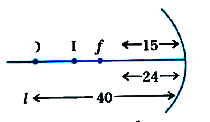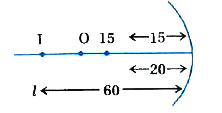An object is placed at a distance of 40 cm from a concave mirror of focal length 15 cm. If the object is displaced through a distance of 20 cm towards the mirror, the displacement of the image will be Solution in Gujrati
36 cm towards the mirror
30 cm away from the mirror
30 cm towards the mirror
36 cm away from the mirror
The correct Answer is:A, C, D

1v1=1f−1u1=u1−fu1f
∴v1=u1fu1−f=(−40)(−15)−40−(−15)
∴v1=600−25=−24 cm
Now u2=-20 cm ,v2=?

1v2=1f.−1u2=u2−fu2f
∴v2=u2fu2−f=(−20)(−15)−20−(−15)
∴v2=300−5=−60 cm
Distance between images = v2−v1
=-60+24
=-36 cm
As distance is positive hence 36 cm away from mirror.
Topper's Solved these Questions
- RAY OPTICS AND OPTICAL INSTRUMENTSBOOK - KUMAR PRAKASHANCHAPTER - RAY OPTICS AND OPTICAL INSTRUMENTSEXERCISE - SECTION-D (MULTIPLE CHOICE QUESTIONS (MCQs))(MCQs FROM .DARPAN. BASED ON TEXTBOOK)(MCQs BASED ON TEXTUAL ILLUSTRATION AND EXERCISE)
24 Videos
- MOVING CHARGES AND MAGNETISMBOOK - KUMAR PRAKASHANCHAPTER - MOVING CHARGES AND MAGNETISMEXERCISE - SECTION D (MCQs ASKED IN COMPETITIVE EXAMS)
34 Videos
- SAMPLE QUESTION PAPER BOOK - KUMAR PRAKASHANCHAPTER - SAMPLE QUESTION PAPER EXERCISE - PART-B SECTION-C
5 Videos
Similar Questions
The earth takes 24 h to rotate once about its axis. How much time does the sun take to shift by 1° when viewed from the earth?
View SolutionElectric charge Q having mass M moves on a circular path of radius R with velocity →v, perpendicular to uniform magnetic field B. When a particle completes one revolution, work done by the field is _______
View SolutionTwo charges –q and +q are located at points (0, 0, –a) and (0, 0, a), respectively.
(a) What is the electrostatic potential at the points (0, 0, z) and (x, y, 0) ?
(b) Obtain the dependence of potential on the distance r of a point from the origin when r/a>>1 .
(c) How much work is done in moving a small test charge from the point (5,0,0) to (–7,0,0) along the x-axis? Does the answer change if the path of the test charge between the same points is not along the x-axis?
View SolutionThe image formed by a concave mirror is twice the size of the object. The focal length of the mirror is 20 cm. The distance of the object from the mirror is//are
View SolutionAn object is placed at a distance of 40 cm from a concave mirrorr of focal length 15 cm . If the object is displaced through a distance of 20 cm towards the mirrorr, the displacement of the image will be
View SolutionAn object is placed at a distance of 40 cm in front of a concave mirror of focal length 20 cm. The image produced is
View Solutionएक अवतल दर्पण की वक्रता त्रिज्या 20 सेमी है। कोई वस्तु अवतल दर्पण से 15 सेमी की दूरी पर रखी है। दर्पण से वस्तु के प्रतिबिम्ब की दूरी ज्ञात कीजिए।
View SolutionIf an object is placed at a distance of 40 cm from a concave mirror of focal length 20 cm , them the image wil be
View SolutionAn object is placed at a distance of 20 cm from the pole of a concave mirror of focal length 10 cm. The distance of the image formed is
View SolutionAn object is placed at a distance of 40 cm from a concave mirror of focal length 15 cm. If the object is displaced through a distance of 20 cm towards the mirror, the displacement of the image will be
View SolutionAn object is placed at a distance of 20 cm from the pole of a concave mirror of focal length 10 cm. The distance of the image formed is
View SolutionAn object is placed at a distance of 40cm from a concave mirror of focal length 15cm. IF the object is displaced through a distance of 20cm towards the mirror, the displacement of the image will be
View SolutionIn an experiment to find the focal length of a concave mirror, an object is placed at a distance of 40 cm from it and forms image at 24 cm from the mirror, then the focal length is
View SolutionAn object is placed at a distance of 40cm from a concave mirrorr of focal length 15cm. If the object is displaced through a distance of 20cm towards the mirrorr, the displacement of the image will be
View SolutionThe image formed by a concave mirror is twice the size of the object. The focal length of the mirror is 20 cm. The distance of the object from the mirror is//are
View Solution
